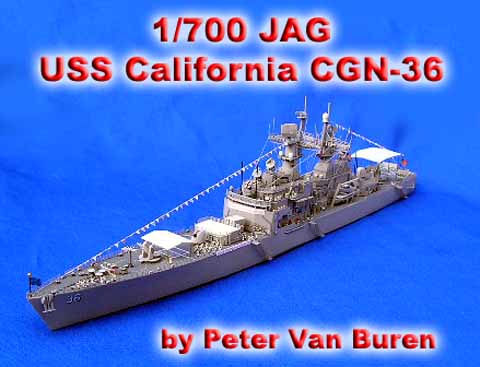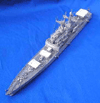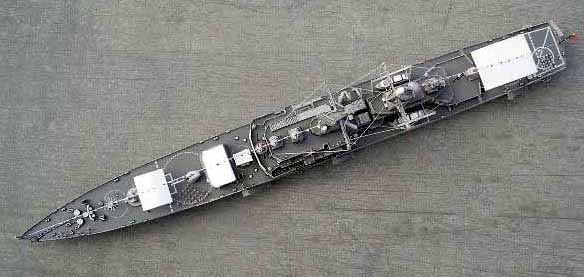
by Peter Van Buren

| This is another well-made kit from JAG of a steady Cold Warrior, the California. The kit is a straight-forward build, and includes decals for both ships of the class, good instructions and all the photo etch needed except ladders and railings. | |||||||||
| Some History
The mission of CALIFORNIA-class nuclear-powered guided missile cruisers is to operate offensively in the presence of air, surface, and subsurface threats. These actions may be performed independently or in support of sealift convoys, high-speed aircraft carrier task forces, or amphibious task forces. The nuclear-powered engineering plant allows the cruiser to conduct operations over extended periods of time anywhere in the world. To accomplish its mission, these ships are equipped with the latest technology and equipment including the New Threat Upgrade modernization. With a fully integrated combat system, it has the capabilities to quickly detect modern threat platforms, perform high-speed data processing and employ powerful weaponry. This was the first class of nuclear-propelled surface warships intended for series production. These ships essentially are nuclear-propelled version of guided missile designs proposed in the early 1960s. To aid in accomplishing their assigned tasks, these ships are equiped with an extensive array of weapons and sensors. They have the older SM-1 series SAM on single arm, Mk13 Mod 3 launchers (fore and aft), two 5 inch guns (fore and aft), anti-ship capability with Harpoon SSMs, the 20mm Close In Weapon System (CIWS) and USW capability with ASROCs, These do not carry TLAMs. Sensors include a 3D air search radar, 2D air search radar, an array of surface search radars and fire control radar systems. They are also equiped with passive electronic surveillance and jamming systems unequaled by any other cruiser in the Navy. These weapons and sensors give them the ability to attack and defend against targets that are over 70 nautical miles away while being able to protect themselfs from close range attacks. Two nuclear reactors provide all the energy required for the propulsion plant and electric generators. The two propulsion plants deliver 70,000 shaft horsepower, allowing sustained speeds in excess of 30 knots (nautical miles per hour) all over the world. On the 04 September 1998 USS South Carolina completed her service to the active fleet of The United States Navy. Beginning the final Deactivation process, on 04 November 1998, the ship entered Drydock 4 at Norfolk Naval Shipyard. As of 01 October 1998 CGN-36 California was in commission in Reserve (Stand Down) at Bremerton WA at the start of the inactivation cycle. |
|||||||||
| The Kit
As is standard with JAG products, the molding is excellent. The hull was totally flat bottomed without any air bubbles or pin holes to wrestle with. JAG molds the hull and the entire superstructure as a single piece, greatly simplifying construction and eliminating seams and clean up work. The detail parts are molded on to resin sprues and appear to be based on Pitroad-Skywave masters. In fact, I lost one of the gun turrets to the carpet monster and vacuum demons and replaced it with a Skywave part—can you tell which is JAG and which is not? |
click images
to enlarge |
||||||||
 |
|||||||||
 |
|||||||||
| A nice feature that keeps platforms and smaller details closer to scale is the use of brass photo etch pieces (see the photos of the unpainted ship). This also brings up a construction point: almost no resin kit instruction set specifies build order, the way many plastic kits lead you through step one (attach rudders) through step 24 (wet decals). Even though most of us don’t rigidly follow Trumpeter’s orders, they do provide a suggested path and many beginners find them helpful. With resin kits, you are more on your own on where to start and what to do first. I’ll suggest that a bit of planning on build order will make for a more pleasant experience—fewer mistakes, knocked off parts, forgotten details, painting touch-ups. | |||||||||
| On this kit, a key build order question is how much of the kit to build first and then paint, versus painting things separately. As you can see from the photos, I suggest building up as much as possible first, then painting. Your call. |  |
||||||||
|
|||||||||
 |
|||||||||
An area to pay particular attention to is the masts. These
are made up of resin parts (the lower platforms and cross arms), brass
(upper platforms and radars) and plastic pieces (vertical parts).
The key here is making sure everything lines up straight. What I
did is use gel-type super glue, which takes a few seconds to set up, and
quickly scan the parts from above and the side while the glue is still
wet so I could make small adjustments. Same for the ships’ boats’
racks and frames, which are made up of both brass and plastic parts.
Go slow if you are new to resin kits on these subassemblies to get everything
square.
|
|||||||||
| Online Resources
Navsource.org has a number of decent photos of the ship in various incarnations. FAS.org has some background on the ship, only two photos but very helpful diagrams of decks layouts, showing various warning lines that help in decal placement. |
|||||||||
|
|
|||||||||
